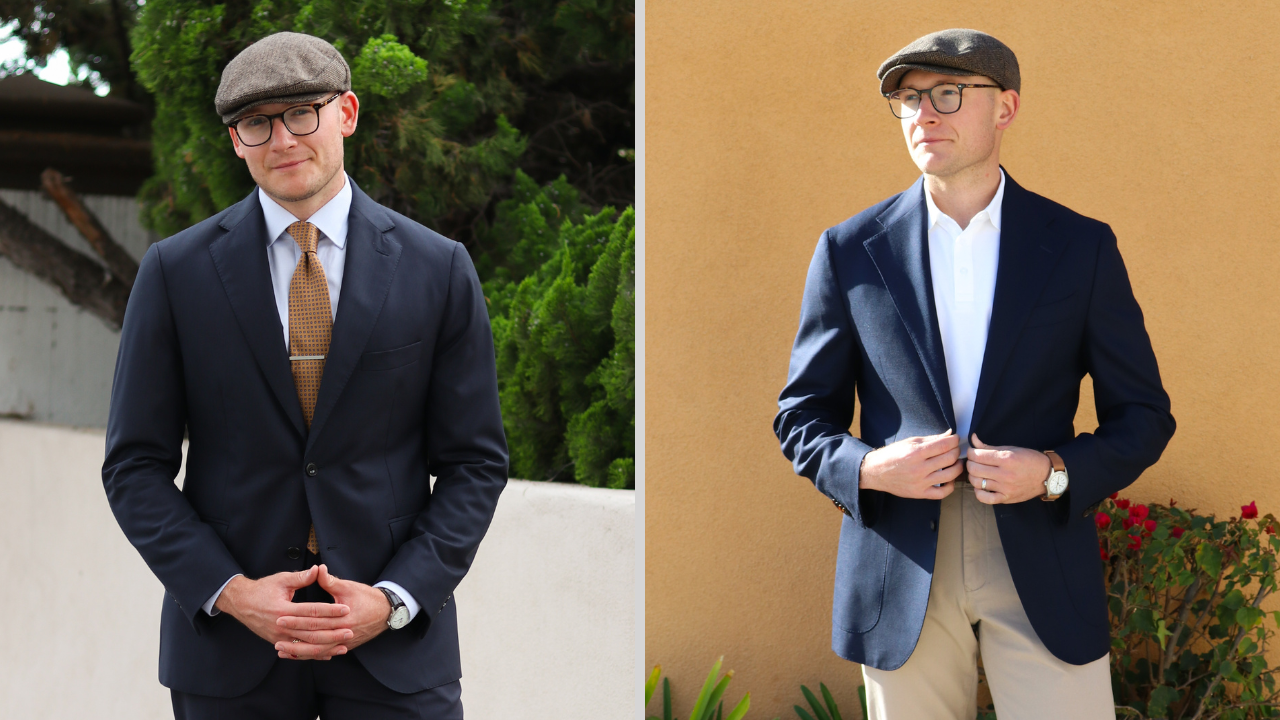
One of menswear's most confusing and frustrating subjects is the distinction between suit jackets and blazers.
Don’t worry! If you've had trouble understanding the difference between a suit jacket and a blazer, here’s everything you need to know.
By the end of this post, you will grasp the key differences between these two pieces, learn when and how to wear them effectively and understand common mistakes to avoid.
I will even describe and showcase how to build a suit whose jacket can also double as a classic navy blazer, allowing you to enjoy the benefits of both timeless menswear pieces.
Let's dive in!
The Suit Jacket

DEFINITION
Kicking things off with what is often (not always) the most formal of the two, we have the suit jacket.
A suit is formally defined as a garment consisting of a jacket and matching trousers, both of which coordinate in fabric, pattern, and color.
MATERIALS
Men's suits can be made from various fabrics; however, most suits are constructed from worsted wool, a lighter, stronger, finely woven wool that often gives the material a distinct "sheen."
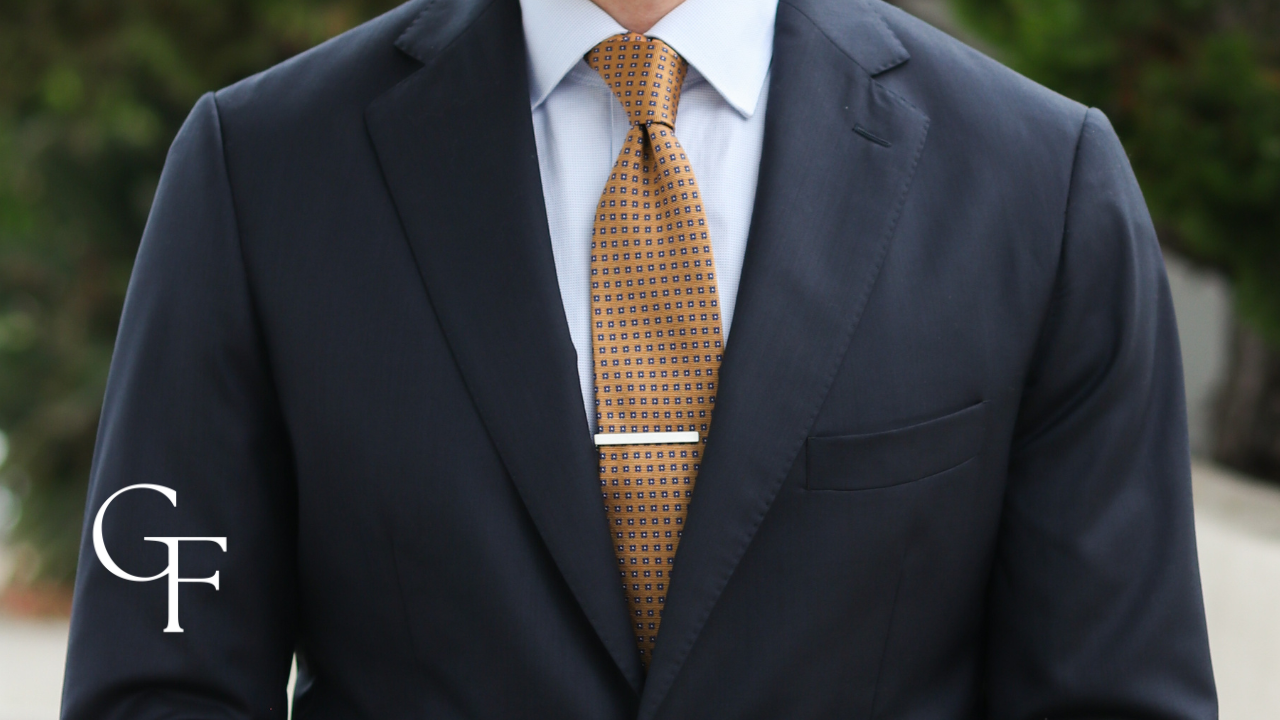
Suits are typically more structured and may feature a full—or half-canvassed lining and shoulder padding, which often enhances their formality.
However, it's important to note that suits and suit jackets can also be unlined and unstructured. It really just depends on where you buy them or how you choose to build them if you're having them made custom.
Many suits may feature casual qualities like patch pockets, minimal lining, padding, canvassing, and textured fabrics. Again, what truly defines a suit is its matching pants and jacket.
For instance, I own two suits: one made from brown tweed and the other from medium gray flannel. My brown tweed jacket has considerable structure, while the gray flannel jacket has little to no lining (see below).
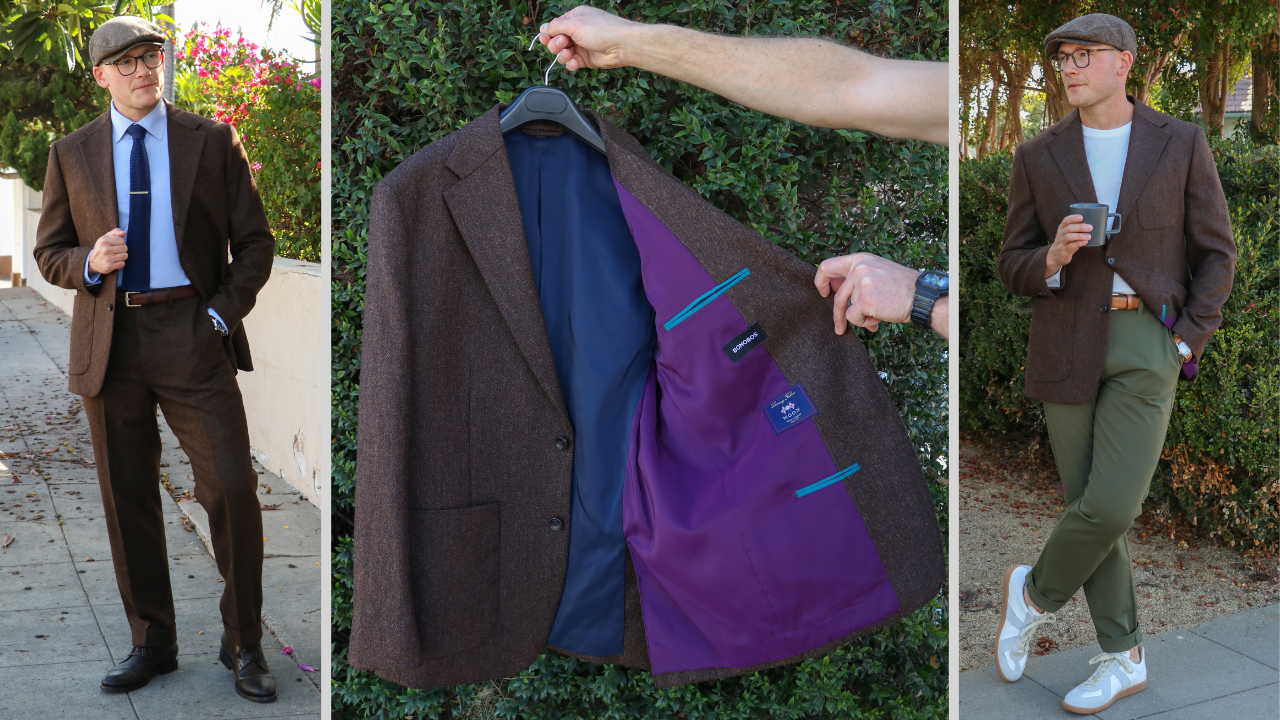
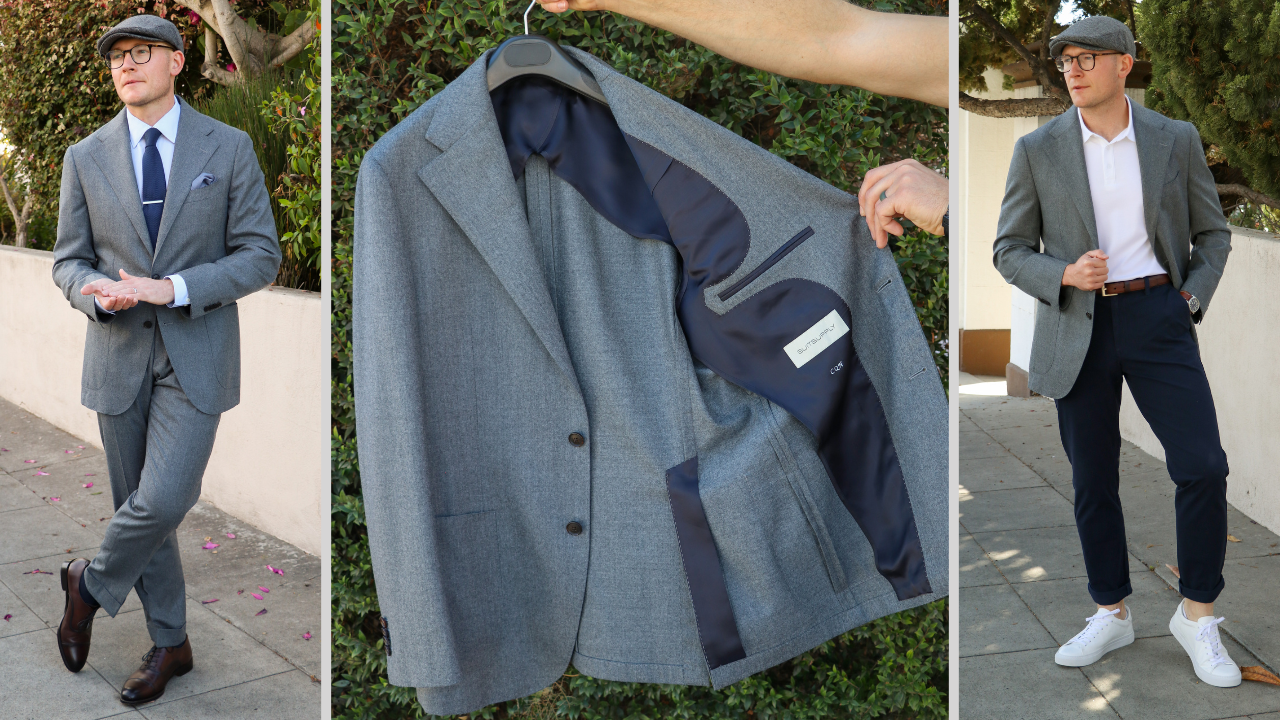
These are both suits, but the jackets can easily be classified as sport coats—not technically blazers—due to their more casual qualities (more on blazers and even sport coats shortly).
WHEN TO WEAR
Every man should own at least one well-fitting navy blue, charcoal, or gray suit. Suits should be reserved for weddings, funerals, or occupations/interviews that require higher standards of formality.
The Blazer
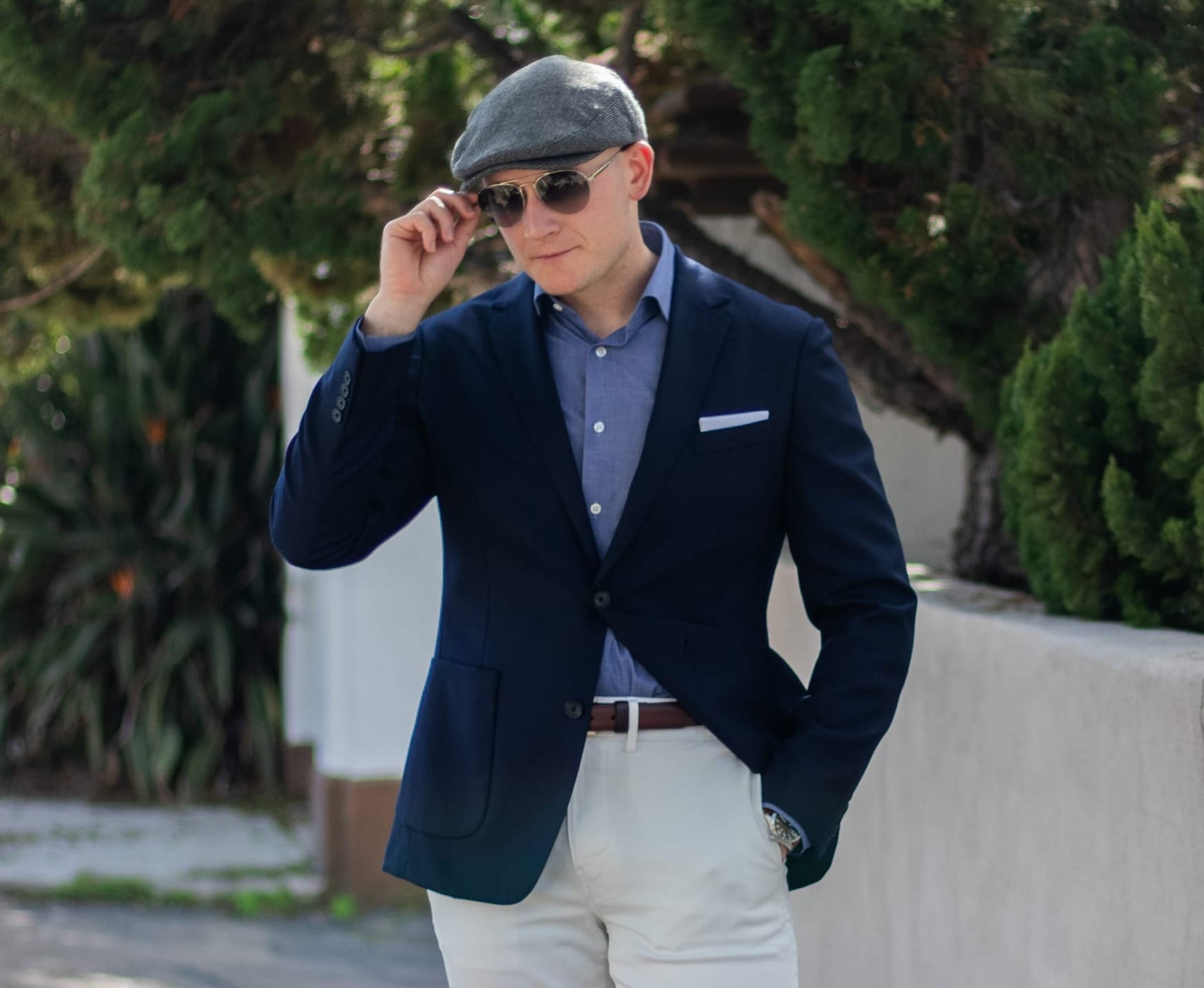
A traditional blazer usually meets specific criteria. Before we explore what qualifies as a blazer, it is important to understand its backstory.
A QUICK HISTORY
Perhaps one of the most significant origins of the blazer is the Lady Margaret Boating Club at St. John's College in Cambridge, England. Founded in 1825, this club is often credited with igniting the jacket's initial popularity during the late 1800s.
Each club member was described as wearing blazing red flannel jackets that were said to be "ablaze." Thus, the rowing regatta blazer in bright, bold colors was born as a stylish menswear staple meant to stand out.
DEFINITION
A blazer is a distinct garment with features similar to a traditional suit, including padded shoulders and canvas construction (though it can also be unstructured).
Blazers are usually single-breasted, but they can also be double-breasted. Depending on your style, they may feature patch pockets, flap pockets, or even ticket pockets.
What fundamentally distinguishes a blazer is that it does not come with matching trousers; therefore, it is a standalone piece that typically features contrasting buttons and other elements, giving it a more casual look.
It is important to note that if a jacket that meets all of the criteria mentioned earlier is paired with matching trousers constructed of the same fabric, patterns, and colors, it would be, by definition, a suit.
MATERIALS
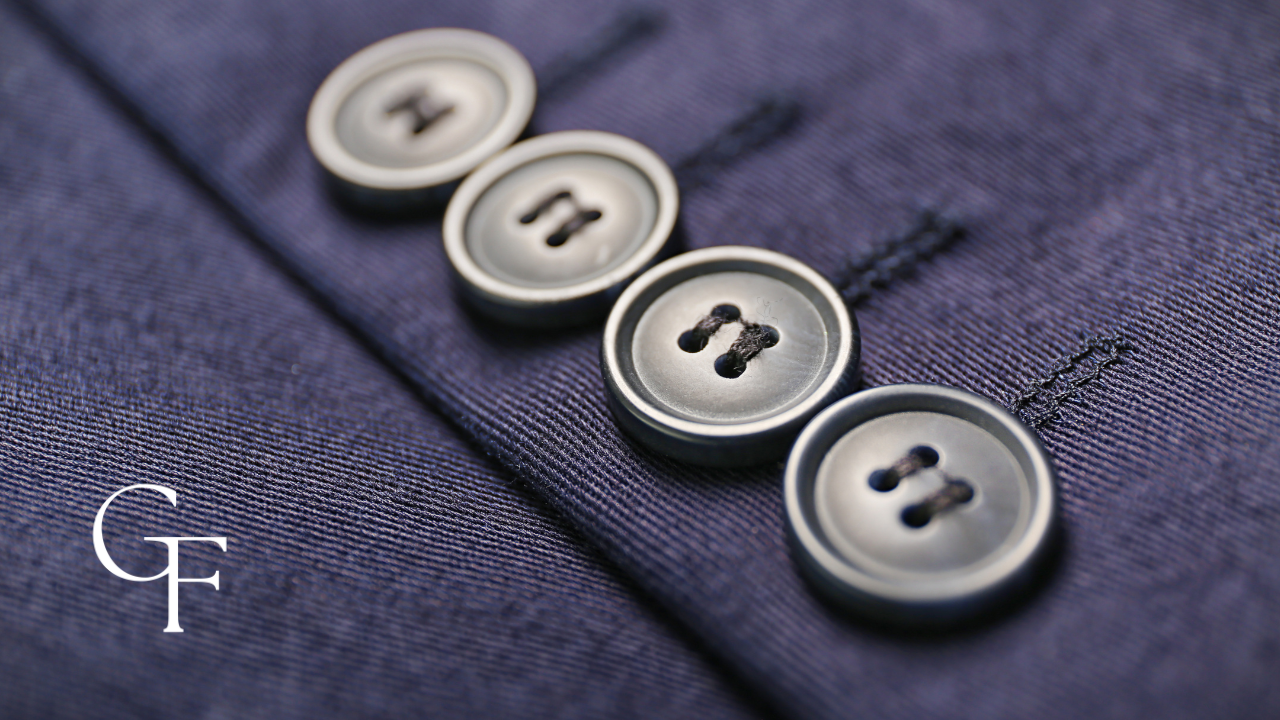
Blazers can be made of various types of wool, such as flannel, hopsack, etc. As mentioned, suits are typically (but not always) made from worsted wool, a tightly woven, smoother fabric often reserved for more formal attire due to its shinier visage.
Flannel, which comes from wool or cotton, is constructed differently, is much softer, and is more casual.
Hopsack is a basket-like, much more breathable four-season fabric made from wool or wool-cotton blends. Due to its construction, hopsack adds a more visible texture and is thus considered much less formal than worsted wool.
PATTERNS
Blazers can be solid (especially in navy blue), striped, or even solid colors with contrasting piping along the edges. In the past, many blazers featured ornamentation, such as a crest, but few now exist outside private institutions.
Nowadays, a blazer is often a solid navy blue color with contrasting buttons. For those looking to be more traditional, bright brass yellow or brilliant mother of pearl will stand out while maintaining a classic look. In contrast, something like a deep brown horn button will be more reserved, often professional, and conservative.
WHEN TO WEAR
As previously mentioned, blazers are less formal than suits but still formal enough to be worn for specific occasions that warrant dressier clothes, such as networking events, business settings, dates, and even weddings (depending on the type of wedding).
When choosing a navy blazer, select one that reflects your personal style and meets your specific needs, such as what is appropriate for your workplace.
What About Sport Coats?

The sport coat (or sports jacket) is the most casual of these three jackets. Like the blazer, it is a standalone piece. Unlike the blazer, however, the sport coat has a reasonably concise history.
Men have traditionally worn this garment for sporting, hunting, or fishing in the countryside, which is where its name comes from. Regarding classic sport coats, flannel, linen, cotton, wool, and tweed jackets are among the most versatile, timeless, and functional.
The sport coat is perfect for looking polished without being overly formal. It's an excellent choice for dates, reunions, outings with friends, or casual parties, making it the ultimate casual jacket for any gentleman who wants to be the best-dressed man in the room without looking like he's trying too hard (even if he secretly is).
How to Wear a Suit Jacket as a Blazer
If your jacket fabric of choice is worsted wool, which has a noticeable sheen typical of most suits, I recommend not wearing it as a blazer.
It can give the impression that you're trying too hard to do more with an orphaned suit jacket than necessary by mixing overly formal pieces with super casual ones, which isn't visually appealing (trust me).
However, suppose the suit jacket has an intricate pattern, and the wool is a hopsack weave or something with an apparent texture; in that case, the nature of the suit jacket is already a little more casual than worsted wool (resembling a classic navy blazer), and therefore you could very well pull it off.
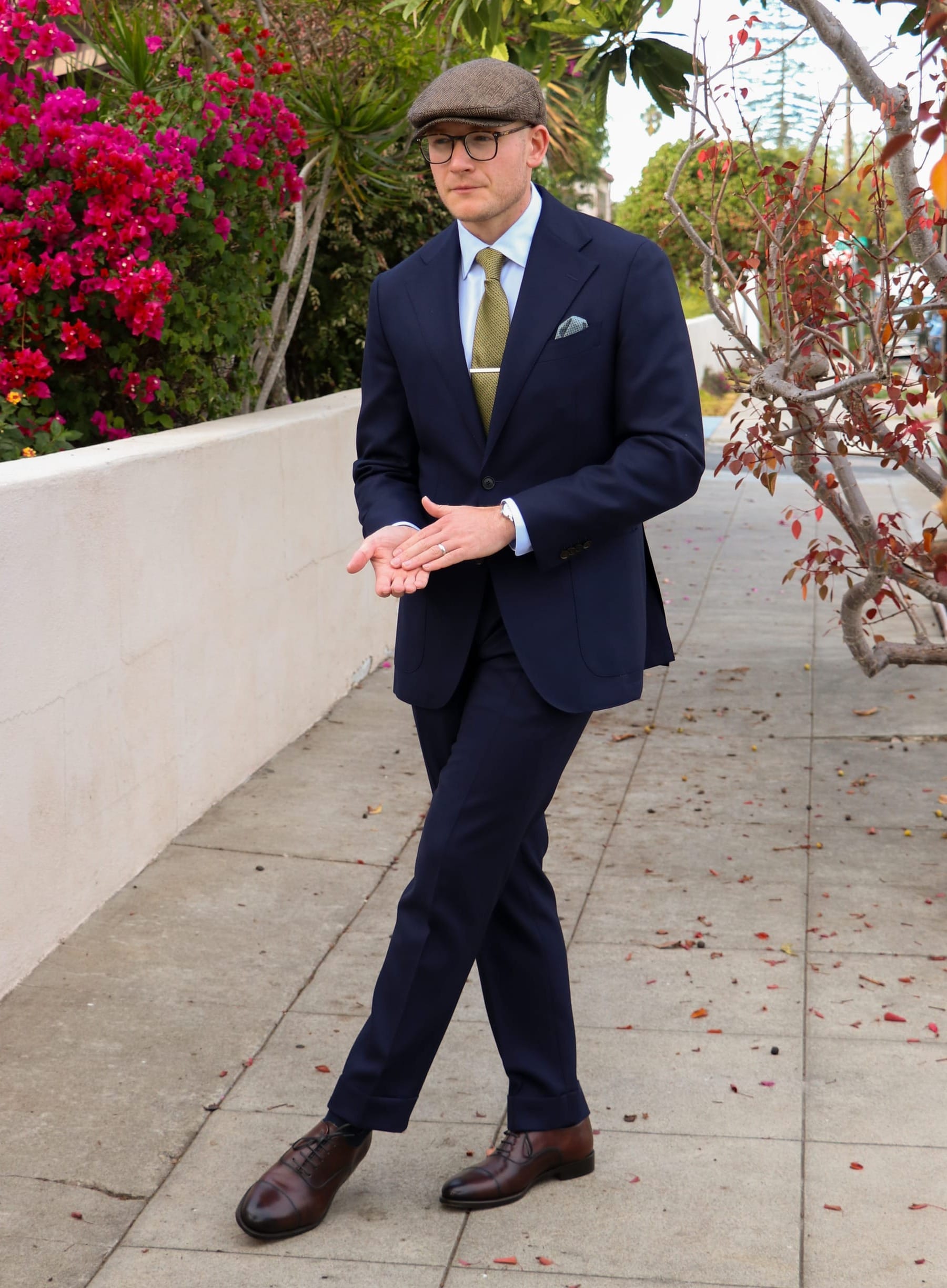
This full suit (featured above) is single-breasted with patch pockets, woven from hopsack wool, has a less structured design, and is a true navy blue.
This suit is one of the best business suits a man can own because it offers a formal appearance with casual elegance. The matching pants function as a handsome and versatile pair of odd trousers that can be worn independently.
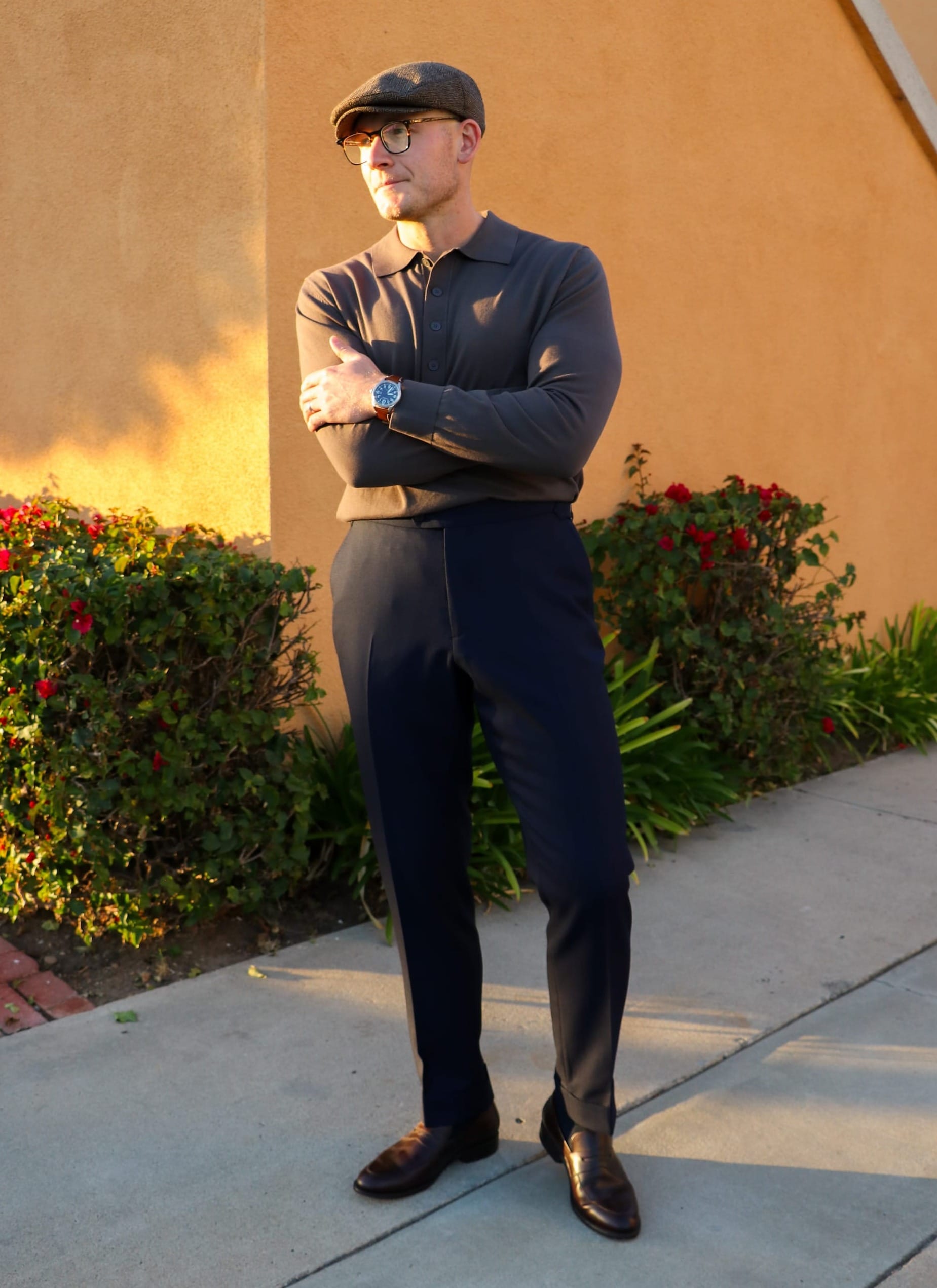
Of course, the jacket meets all the criteria for a navy blazer, allowing it to be separated to create various outfits.
Outfit #1: Smart Casual Blazer & Chinos
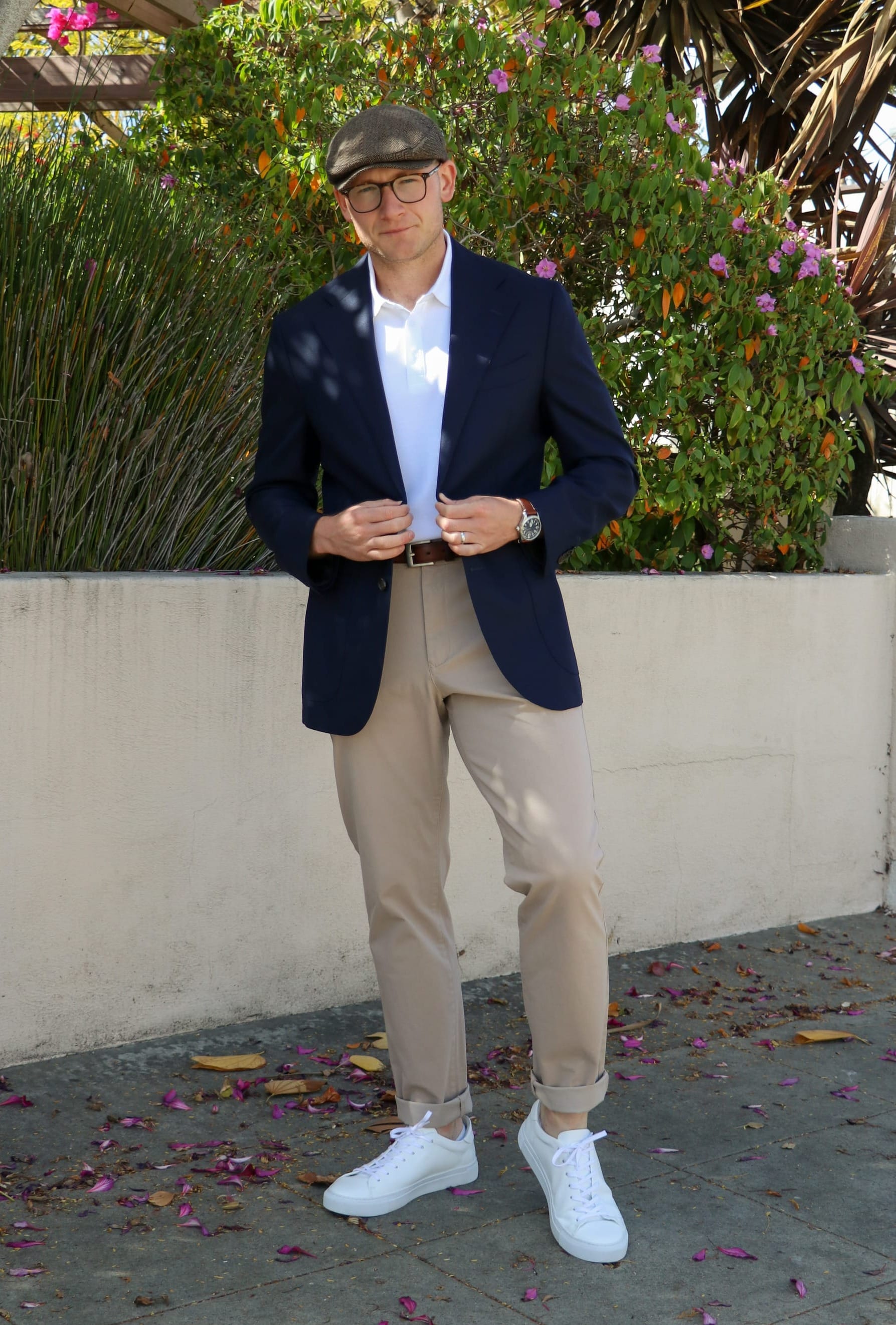
Twenty years ago, an overly casual look like this wouldn't have been acceptable in almost any office setting, but today, the definition of "business casual" has changed dramatically.
Adding clean white leather sneakers and cuffed khaki chinos may not be a style everyone can adopt at work. Still, depending on how your boss defines "business casual," this could be a great way to modernize and casualize a traditional business casual look while still firmly keeping it within the smart casual category of the business casual spectrum.
Outfit #2: "Casual" Business Casual

Here, we have the same outfit, but this time, it's a bit more formal with the addition of brown leather loafers. While not the most formal shoes, loafers are still an elegant and sophisticated choice that any man can benefit from owning.
This style demonstrates how changing just one item can alter an outfit's overall appearance and feel.
Outfit #3: Formal Business Casual

You're probably accustomed to seeing a look like this in movies, on television, in magazines, or online. This classic menswear "uniform" will always stay stylish for dressier office occasions.
My navy blazer is paired with handsome wool flannel dress pants, an ice-blue dress shirt, and a textured red grenadine necktie.
Naturally, brown oxford dress shoes make a logical choice due to their timeless silhouette and deep color.
Should You Own a Navy Blazer?
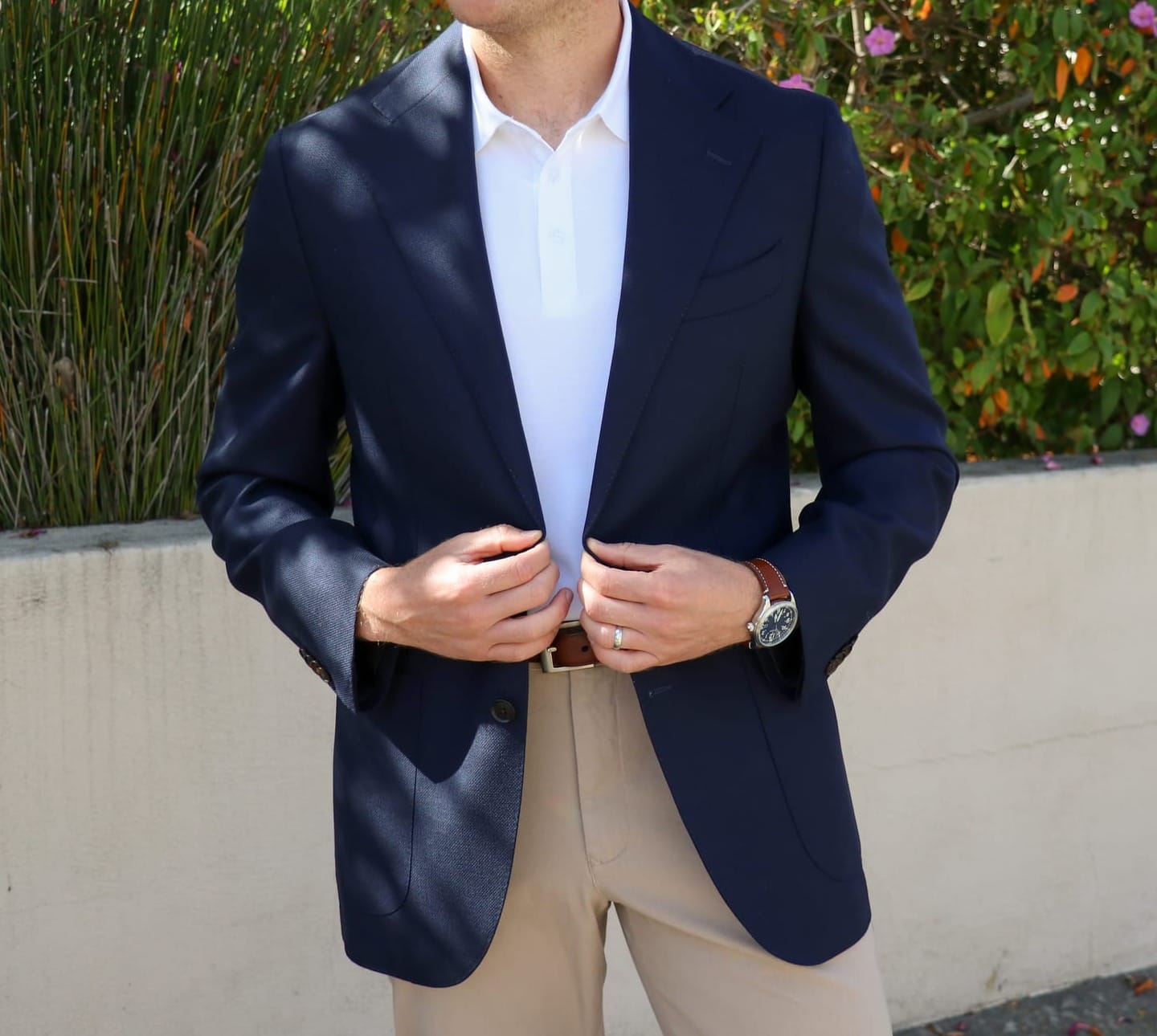
The navy blazer is a timeless and classic wardrobe piece that every man can use to great effect. It has remained an iconic staple for several decades and can be paired with nearly endless outfit combinations.
While not necessarily essential, a blazer can elevate any man's look all year round, provided it's worn tastefully and thoughtfully.
While this jacket is versatile and timeless, not every man needs one. Instead, for more formal events, prioritize a well-fitting navy blue, charcoal, or gray suit.
That said, if you work in a professional setting with a business casual dress code, I highly recommend investing in a navy blazer like the one I previously described and showcased: true navy blue made from hopsack wool.
Knowledge Is Power
The difference between a suit jacket and a blazer is important but certainly not so significant that one should engage in lengthy debates about it. If we're being honest, arguing about specific terminology can come off as snobbish, so I wouldn't let it bother you too much.
What matters most is a solid understanding of the distinctions among these classic menswear pieces to dress appropriately for different occasions and choose garments that resonate with our personal style and complement our tastes.


